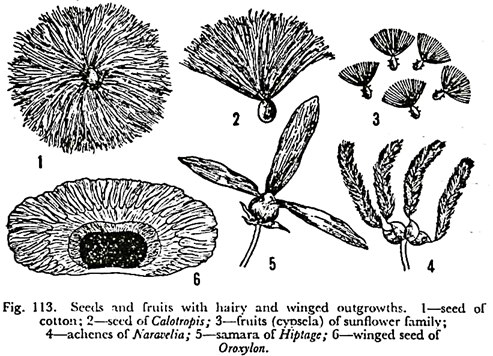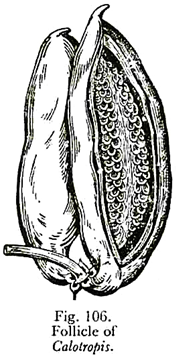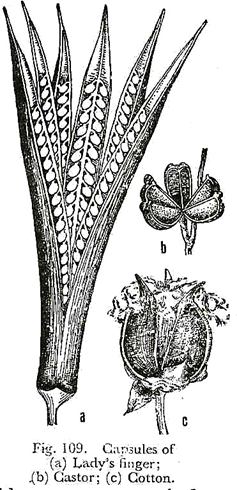In this article we will discuss about the classification of fruits:- 1. Simple Fruits 2. Aggregate Fruits 3. Multiple Fruits.
Group # 1. Simple Fruits:
Simple fruits may be dry or fleshy, according to the nature of the pericarp. Some dry fruits burst automatically to liberate the seeds. They are called dehiscent; others which do not dehisce are indehiscent fruits.
Dry indehiscent fruits are usually one-seeded. Following are the types:
(a) Achene is a dry indehiscent one-seeded fruit from a superior simple pistil where the seed coat is separable from the pericarp, e.g. Naraveha (B. Chagalbati, Fig. 113, 4).
(b) Caryopsis is just like an achene but the seed coat and pericarp are inseparably united, e.g. maize, grasses.
(c) Cypsela is a one-seeded fruit from an inferior bicarpellary pistil, as in sunflower (Fig. 113, 3).
(d) Nut is a one-seeded fruit from a superior bi- or polycarpellary pistil with tough and woody pericarp, e.g. chestnut.
(e) Samara is the same type of fruit with a pair of winged outgrowths, e.g. Hiptage (B. Madhabilata), Dipterocarpus (B. Garian, Fig. 113, 5).
(f) Schizocarpic fruits are dry indehiscent ones from inferior bicarpellary pistil. After ripening the two one-seeded parts separate and remain attached to an axis , coriander , anise (B. Mouri, fig .105)
Dry Dehiscent Fruits:
(a) Follicle is a dry dehiscent fruit from a monocarpellary pistil which dehisces by one suture only, along the ventral suture, e.g. Calotropis (B. Akanda, Fig. 106).
(b) Legume or Pod is a many-seeded fruit from a monocarpellary pistil which dehisces by both the sutures, ventrally and dorsally, e.g. pea (Fig. 107), Crotolaria (B. Atasi). Legume is often constricted into one-seeded parts. It is called lomentum, e.g. Acacia (B. Babla).
(c) Siliqua is a dry dehiscent many-seeded fruit from a superior bicarpellary pistil which dehisces from the base upwards. The seeds remain attached to a false partition wall called replum, e.g. radish, mustard (Fig. 108).
(d) Capsule is a dry many- chambered fruit from a polycarpellary pistil which dehisces by splitting into a number of parts, e.g. Datura, cotton, lady’s finger (Fig. 109).
Fleshy Fruits (Fig. 110):
Fleshy fruits have succulent or juicy pericarp. They are usually indehiscent. Seeds are set free after decomposition of the pulp.
(а) Drupe is a fleshy fruit with one or more seeds from a monocarpellary or polycarpellary syncarpous pistil where the pericarp is differentiated into outer epicarp, juicy mesocarp and stony endocarp, e.g. mango [Fig. 110 (A & B)], Indian plum, etc. Cocoanut is a fibrous drupe in which mesocarp is not juicy but fibrous.
(b) Berry or Bacca is a fleshy fruit, usually many-seeded, from a simple or compound pistil where stony endocarp is lacking and seeds remain freely in the pulp, e.g. tomato [Fig. 110 (C & D)], brinjal, banana.
(c) Pepo is a fleshy fruit like a berry from an inferior syncarpous pistil with parietal placentation. Seeds remain attached in series to the placentae. Pepo has usually a tough rind, e.g. gourd [Fig. 110 (E&F)].
(d) Pome is a false fleshy fruit from cyncarpous pistil surrounded by thalamus, which, in fact, forms the main edible part of the fruit, e.g. apple [Fig. 110 (G & H)], pear.
(e) Hesperidium is a many-chambered fruit from a syncarpous pistil where epicarp and mesocarp unite to form the separable rind. Many juicy hairs develop from the pericarp, which constitute the edible part of the fruit, e.g. orange [Fig. 110 (I & J)], lemons.
Group # 2. Aggregate Fruits:
We know that the aggregate fruits develop from polycarpellary apocarpous pistil. The aggregate or group of fruits from a single flower is known as an etaerio. They may be eiaerio of achenes, as in Naravelia (B. Chagalbati), etaerio of berries, as in Artabotrys (B. Kantali champa, Fig. 111).
Group # 3. Multiple Fruits:
Due to the stimulus of fertilisation often the whole of inflorescence develops into a single fruit. These types of fruits are multiple.
(a) Sorosis is a multiple fruit from an inflorescence spadix with fleshy axis, e.g. pine-apple (Fig. 112), jack fruit.
(b) Syconus develops from the special inflorescence, hypanthodium with fleshy hollow receptacle, e.g. fig.









